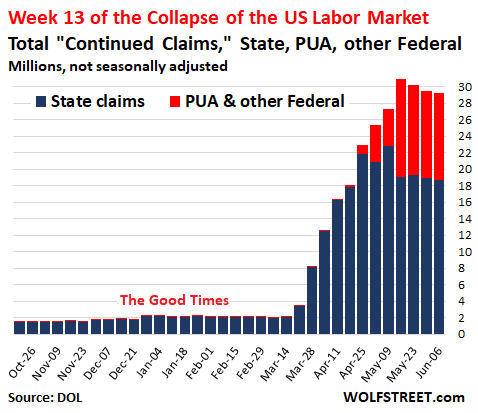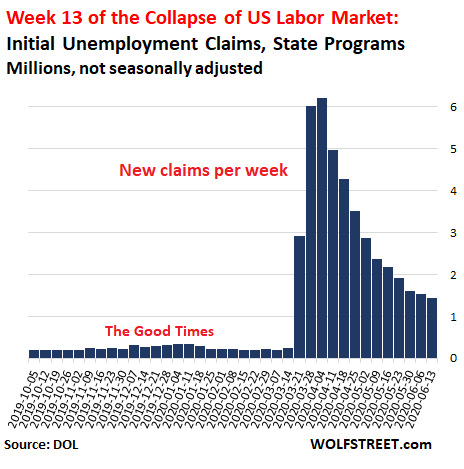29.2 million people still claim unemployment insurance, gig workers 1/3 of total. Some states still not processing claims under federal programs. My “Reasonable Approximation” for the Unemployment Rate.
By Wolf Richter for WOLF STREET.
The unemployment crisis – by far the worst since this type of data has been tracked – stopped getting worse in May and has lessened for the third week in a row, but lessened at snail’s pace, and it’s still so enormous that the improvements are relatively tiny.
Under all state and federal unemployment insurance programs combined, including the federal Pandemic Unemployment Assistance (PUA) for gig workers, a total of 29.2 million people (not seasonally adjusted) are still claiming unemployment insurance, the Department of Labor reported this morning. This is down from 29.5 million last week, and from 30.2 million the week before. The chart below shows in blue the number of people receiving unemployment benefits under state programs, and in red the number of people receiving federal benefits, mostly gig workers:

A few weeks ago, I switched to reporting only not-seasonally adjusted data for unemployment claims because the seasonal adjustments were not designed for a crisis of this magnitude, and the results went haywire.
In addition, the Labor Department revises seasonally adjusted data, often heavily, the following week, and dealing with them is like trying to nail Jell-O to the wall. Not seasonally adjusted data are not revised and present a more accurate picture.
Still a flood of initial state unemployment claims.
The flood of initial unemployment claims under state programs continues: 1.43 million initial claims (not seasonally adjusted) were processed in the week ended June 13, down from 1.54 million a week ago. While down a whole bunch from this tsunami in late March, this is still more than double the records of the prior unemployment crises in 1982 and 2009.

In other words, people who qualify for state unemployment benefits – regular employees as opposed to gig workers – are still getting laid off in very large numbers. There are bits and pieces of evidence emerging that a larger portion of those layoffs are now from companies that were not part of the initial shutdowns of restaurants, bars, retailers, hotels, and other businesses, but from higher-paying jobs across industries.
The number of people who continue to claim unemployment benefits a week or more after their initial claim under state programs become part of the “insured unemployed.” This number of people with “continued claims” under state programs declined to 18.65 million in the current week, from 18.92 million in the prior week (the blue segments of the columns in the first chart above).
In other words, more people got hired back or found another job – including at retailers, restaurants, dental practices, etc., that have reopened – than were added to the state unemployment rolls.
Federal programs: gig workers are 1/3 of insured unemployed.
Pandemic Unemployment Assistance: Gig workers are now covered under the federal PUA program, which is administered by state unemployment offices. In total, 760,526 initial PUA claims were processed in the week ending June 13.
And 9.28 million gig workers receive PUA benefits, down from 9.73 million in the prior week. In other words, here too, more gig workers started working again, and their number was larger than the number of gig workers who lost their work and filed unemployment claims.
These out-of-work gig workers account for about one-third of all insured unemployed. The PUA claims system now demonstrates for the first time just how exposed gig workers are, and how many of them lose their work in a crisis.
Pandemic Emergency Unemployment Compensation. Continued claims under the federal PEUC program more than doubled during the week to 1.08 million.
Other federal programs include those that cover laid-off federal employees (15,514 continued claims) and Newly Discharged Veterans (11,901 continued claims).
Some states still behind in processing claims
The PUA program for gig workers was difficult to implement for states. Some scrambled to get it done, others still haven’t gotten it done. But every week, more states start processing these claims. As of today’s report, six states still have not processed any claims by gig workers under the PUA program, including the biggie, Florida:
- Arkansas
- Florida
- Georgia
- New Hampshire
- Oregon
- West Virginia
And 16 states have not yet processed any claims under the federal PEUC program, including the biggie, Florida. As these states eventually figure out how to do it and catch up, they will trigger additional claims under the PUA and PEUC programs.
There continue to be reports that some states are still having trouble catching up with the tsunami of state unemployment claims, and that many laid-off workers were still not able to file their UI claim.
What does all this mean?
I’m now fairly sure that the unemployment crisis bottomed out in May. A large number of people are still losing their jobs, and now an increasing number of those lost jobs are higher-paying jobs. But other people are finding new jobs or are being called back. And the people who start working again in a particular week now outnumber the people who lost their jobs in that week.
Beyond the official Data Chaos: “over 30 million people” lost their jobs and remain unemployed. The two US agencies that are reporting unemployment data – every Thursday, the Department of Labor with its claims for unemployment insurance; and at the beginning of every month, the Bureau of Labor Statistics with its survey-based jobs report – disagree widely on the unemployment numbers: a difference between these two agencies of about 9 million unemployed, as I pointed out last week. The BLS has gone off the deep end for systematic reasons and officially admits to at least part of its errors.
So our most accurate stab at the unemployment situation in the US is the Labor Department’s unemployment insurance data – the 29.2 million people still claiming unemployment insurance under all programs. But states are still behind processing claims, and some people who lost their work don’t qualify for any benefits. So, all added up, it’s still reasonable to say that “over 30 million people” lost their jobs and are still unemployed and want to work.
My “Reasonable Approximation” for the unemployment rate: 20%+. The unemployment rate is in the eye of the beholder. Both agencies report various unemployment rates, and they’re all over the place. In early June, the BLS reported that the unemployment rate dropped to 13.3%.
But there is a way to approximate it: 29.2 million people claim unemployment insurance, in a labor force of 158.3 million, for a rate of 18.4%. Add the people who lost their jobs but don’t qualify for unemployment insurance, and add the people who never worked, or who haven’t worked recently, but want to work and cannot find a job, such as recent graduates, and suddenly the unemployment rate is well above 20%. And the term, an unemployment rate of “above 20%” seems like a reasonable approximation of the current conditions of the labor market.